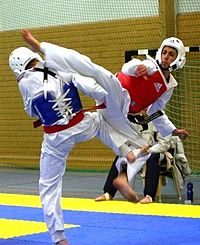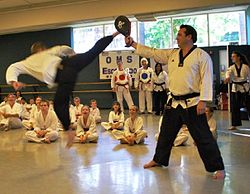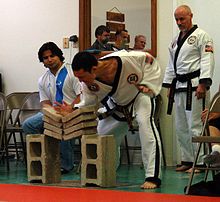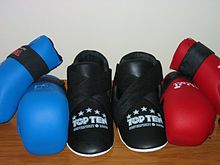
Taekwondo
Background to the schools Wikipedia
SOS Children, an education charity, organised this selection. To compare sponsorship charities this is the best sponsorship link.
 |
|
|---|---|
 A World Taekwondo Federation taekwondo sparring match |
|
| Also known as | Taekwon-Do, Tae Kwon-Do, Tae Kwon Do |
| Focus | Striking |
| Country of origin | |
| Famous practitioners | Hee Il Cho, Chang Keun Choi, Choi Hong Hi, Kwang Jo Choi, Young Il Kong, Han Cha Kyo, Nam Tae Hi, Jong Soo Park, Jung Tae Park, Chong Chul Rhee, Jhoon Rhee, Ki Ha Rhee |
| Olympic sport | Since 1988 ( WTF regulations) |
| Taekwondo | |
|---|---|
| Hangul | 태권도 |
| Hanja | 跆拳道 kuduak |
| Revised Romanization | Taegwondo |
| McCune–Reischauer | T'aekwŏndo |
Taekwondo / ˌ t aɪ ˌ k w ɒ n ˈ d oʊ / (Korean 태권도 ( 跆拳道) [tʰɛk͈wʌndo]) is a martial art originating in Korea. It combines combat and self-defense techniques with sport and exercise. In 1989, taekwondo was the world's most popular martial art. Gyeorugi (pronounced [kjʌɾuɡi]), a type of sparring, has been an Olympic event since 2000.
There are two main branches of taekwondo development, although they are not mutually exclusive. "Traditional taekwondo" typically refers to the martial art as it was established in the 1950s and 1960s in the South Korean military, and in various civilian organisations, including schools and universities. In particular, the names and symbolism of the traditional patterns often refer to elements of Korean history, culture and religious philosophy. 'Traditional Taekwon-Do' may refer to ITF Taekwon-Do as created by the founder of ITF Taekwon-Do General Choi Hong Hi on April 11, 1955. "Sport taekwondo" has developed in the decades since the 1950s and may have a somewhat different focus, especially in terms of its emphasis on speed and competition (as in Olympic sparring). Sport taekwondo is in turn subdivided into two main styles; one is practiced by WTF Taekwondo practitioners, and derives from Kukkiwon, the source of the sparring system sihap gyeorugi which is now an event at the summer Olympic Games and which is governed by the World Taekwondo Federation (WTF). Today, the Kukkiwon, or World Taekwondo Headquarters is the traditional centre for WTF taekwondo; founded by Dr Kim Un Yong on May 25, 1973.. The other comes from the International Taekwon-Do Federation (ITF).
Although there are doctrinal and technical differences between sparring in the two main styles and among the various organizations, the art in general emphasizes kicks thrown from a mobile stance, employing the leg's greater reach and power (compared to the arm). Taekwondo training generally includes a system of blocks, kicks, punches, and open-handed strikes and may also include various take-downs or sweeps, throws, and joint locks. Some taekwondo instructors also incorporate the use of pressure points, known as jiapsul, as well as grabbing self-defense techniques borrowed from other martial arts, such as hapkido, judo or ssireum.
In Korean, tae (태, 跆) means "to strike or break with foot"; kwon (권, 拳) means "to strike or break with fist"; and do (도, 道) means "way", "method", or "path". Thus, taekwondo may be loosely translated as "the way of the foot and the hand." The name taekwondo is also written as taekwon-do, tae kwon-do or tae kwon do by various organizations.
History
The oldest Korean martial art was an amalgamation of unarmed combat styles developed by the three rival Korean Kingdoms of Goguryeo, Silla, and Baekje, where young men were trained in unarmed combat techniques to develop strength, speed, and survival skills. The most popular of these techniques was ssireum and subak with taekkyeon being the most popular of the segments of subak. The Northern Goguryeo kingdom was a dominant force in Northern Korea and North Eastern China prior to common era and again from the 3rd century to the 6th century CE. Before the fall of Goguryeo Dynasty 6th century CE, the Shilla Kingdom asked for help in training its people for defence against pirate invasions. During this time a few select Silla warriors were given training in taekkyeon by the early masters from Koguryo. These Shilla warriors then became known as the Hwarang. The Hwarang set up a military academy for the sons of royalty in Silla called Hwarang-do, which means "the way of flowering manhood." The Hwarang studied taekkyeon, history, Confucian philosophy, ethics, Buddhist morality, social skills and military tactics. The guiding principles of the Hwarang warriors were based on Won Gwang's five codes of human conduct and included loyalty, filial duty, trustworthiness, valor and justice. Taekkyeon was spread throughout Korea because the Hwarang traveled all around the peninsula to learn about the other regions and people.
In spite of Korea's rich history of ancient and traditional martial arts, Korean martial arts faded into obscurity during the late Joseon Dynasty. Korean society became highly centralized under Korean Confucianism and martial arts were poorly regarded in a society whose ideals were epitomized by its scholar-kings. Formal practices of traditional martial arts such as subak and taekkyeon were reserved for sanctioned military uses. However, taekkyeon persisted into the 19th century as a folk game during the May-Dano festival and was still taught as the Military Martial Art under the last emperor of the Choson Dynasty.
During the occupation, Koreans who were able to study in Japan were exposed to Japanese martial arts. Others were exposed to martial arts in China and Manchuria.
When the occupation ended in 1945, Korean martial arts schools ( kwans) began to open in Korea under various influences. There are differing views on the origins of the arts taught in these schools. Some believe that they taught martial arts that were based primarily upon the traditional Korean martial arts taekkyon and subak, or that taekwondo was derived from native Korean martial arts with influences from neighboring countries. Still others believe that these schools taught arts that were almost entirely based upon karate.
In 1952, at the height of the Korean War, there was a martial arts exhibition in which the kwans displayed their skills. In one demonstration, Nam Tae Hi smashed 13 roof tiles with a punch. Following this demonstration, South Korean President Syngman Rhee instructed Choi Hong Hi to introduce the martial arts to the Korean army. By the mid-1950s, nine kwans had emerged. Syngman Rhee ordered that the various schools unify under a single system. The name "taekwondo" was submitted by either Choi Hong Hi (of the Oh Do Kwan) or Song Duk Son (of the Chung Do Kwan), and was accepted on April 11, 1955. As it stands today, the nine kwans are the founders of taekwondo, though not all the kwans used the name. The Korea Taekwondo Association (KTA) was formed in 1959/1961 to facilitate the unification.
In the early 1960s, taekwondo made its début worldwide with assignment of the original masters of taekwondo to various countries. Standardization efforts in South Korea stalled, as the kwans continued to teach differing styles. Another request from the Korean government for unification resulted in the formation of the Korea Tae Soo Do Association, which changed its name back to the Korea Taekwondo Association in 1965 following a change of leadership. The International Taekwon-Do Federation was founded in 1966, followed by World Taekwondo Federation in 1973.
Since 2000, taekwondo has been one of only two Asian martial arts (the other being judo) that are included in the Olympic Games; it became a demonstration event starting with the 1988 games in Seoul, and became an official medal event starting with the 2000 games in Sydney. In 2010, taekwondo was accepted as a Commonwealth Games sport.
One source has estimated that as of 2009, taekwondo was practiced in 123 countries, with over 30 million practitioners and 3 million individuals with black belts throughout the world. The South Korean government in the same year published an estimate of 70 million practitioners in 190 countries.
Features
Taekwondo is known for its emphasis on kicking techniques, which distinguishes it from martial arts such as karate or southern styles of kung fu. The rationale is that the leg is the longest and strongest weapon a martial artist has, and kicks thus have the greatest potential to execute powerful strikes without successful retaliation.
Taekwondo as a martial art is popular with people of both genders and of many ages. Physically, taekwondo develops strength, speed, balance, flexibility, and stamina. An example of the union of mental and physical discipline is the breaking of wooden boards, bricks or tiles, which requires both physical mastery of the technique and the concentration to focus one's power.
A taekwondo student typically wears a uniform ( dobok 도복/道服), often white but sometimes black (or other colors), with a belt (dti 띠) tied around the waist. There are at least three major styles of do-bok, with the most obvious differences being in the style of jacket: (1) the cross-over front jacket that resembles traditional Asian clothing, (2) the V-neck jacket (no cross-over) typically worn by WTF practitioners, and (3) the vertical-closing front jacket (no cross-over) typically worn by ITF practitioners. The belt colour and any insignia thereon indicate the student's rank. In general, the darker the colour, the higher the rank. The school or place where instruction is given is called the do-jang (도장). The grandmaster of the do-jang is called a gwan-jang-nim (관장님); Master (senior instructor or head of do-jang) is called sa-beom-nim (사범님); Instructor is called gyo-san-nim (교사님); Assistant Instructor is called jo-gyo-nim (조교님)
Taekwondo, along with many other martial arts, is traditionally performed in bare feet, though there are specialist training shoes that can sometimes be worn.
Although each taekwondo club or school will be different, a student typically takes part in most or all of the following:
- Learning the techniques and curriculum of taekwondo
- Both anaerobic and aerobic workout, including stretching
- Self-defense techniques (hosinsool 호신술)
- Patterns (also called forms, poomsae 품새/品勢, teul 틀, hyeong 형/型)
- Sparring (called gyeorugi 겨루기, or matseogi 맞서기 in the ITF), which may include 7-, 3-, 2- and 1-step sparring, free-style sparring, arranged sparring, point sparring, and other types
- Relaxation and meditation exercises; breathing control
- Throwing and/or falling techniques (deonjigi 던지기 and ddeoreojigi 떨어지기)
- A focus on mental and ethical discipline, etiquette, justice, respect, and self-confidence
- Breaking (gyeokpa 격파 or weerok), using techniques to break boards for testing, training and martial arts demonstrations. Demonstrations often also incorporate bricks, tiles, and blocks of ice or other materials. Can be separated into three types:
- Power breaking – using straightforward techniques to break as many boards as possible
- Speed breaking – boards are held loosely by one edge, putting special focus on the speed required to perform the break
- Special techniques – breaking fewer boards but using jumping or flying techniques to attain greater heights, distances, or to clear obstacles
- Exams to progress to the next rank
Some schools teach the "sine wave" technique when performing patterns. This involves raising one's center of gravity between techniques, then lowering it as the technique is performed, producing the up-and-down movement from which the term "sine wave" is derived. Other schools teach that one's centre of gravity should remain generally constant throughout the performance of a pattern except where the pattern's description states otherwise.
Organizations
Two of the most popular systems of taekwondo are named solely after their respective organizations: the World Taekwondo Federation (WTF) and the International Taekwon-Do Federation (ITF).
The WTF was founded in 1973, with roots in the KTA. The KTA Central Dojang had been opened in South Korea in 1972, and a few months later, the name was changed to the Kukkiwon. The following year, the WTF was formed. The International Olympic Committee recognized the WTF and taekwondo sparring in 1980.
Although the terms "WTF" and "Kukkiwon" are often mistakenly used interchangeably, the Kukkiwon is a completely different organization which trains and certifies instructors and issues official dan and poom certificates worldwide. The Kukkiwon has its own unique physical building that contains the administrative offices of Kukkiwon (World Taekwondo Headquarters) in Seoul, South Korea and is the system of taekwondo. The WTF is a tournament committee and is not technically a style or a system.
The ITF was founded in 1966 by Choi Hong Hi as a splinter group from the KTA. After Choi's death in 2002, a number of succession disputes splintered the ITF into three different groups, all claiming to be the original. These three bodies are all private organizations. Two are located in Austria and one in Canada. The unofficial training headquarters of the ITF is located at the Taekwondo Palace in Pyongyang, North Korea, and was founded in the mid-1990s. There are many other private organizations, such as the World Traditional Taekwondo Union and American Taekwondo Association promoting the Songahm style of taekwondo and Rhee Taekwon-Do teaching the military style of taekwondo. Events and competitions held by private organizations are mostly closed to other taekwondo students. However, the WTF-sanctioned events allow any person, regardless of school affiliation or martial arts style, to compete in WTF events as long as he or she is a member of the WTF Member National Association in his or her nation, which is open to anyone to join. The major technical differences among these many organizations revolve around the patterns, called hyeong 형, poomsae 품새, or teul 틀, sets of prescribed formal sequences of movements that demonstrate mastery of posture, positioning, and technique, sparring rules for competition, and philosophy.
In addition to these private organizations, the original schools ( kwans) that formed the organization that would eventually become the Kukkiwon continue to exist as independent fraternal membership organizations that support the WTF and the Kukkiwon. The official curriculum of the kwans is that of the Kukkiwon. The kwans also function as a channel for the issuing of Kukkiwon dan and poom certification (black belt ranks) for their members.
Ranks, belts, and promotion
Taekwondo ranks are typically separated into "junior" and "senior," or "student" and "instructor," sections. The junior section typically consists of ten ranks indicated by the Korean word geup 급 (also Romanized as gup or kup). The junior ranks are usually identified by belts of various colors, depending on the school, so these ranks are sometimes called "colour belts". Geup rank may be indicated by stripes on belts rather than by colored belts. Students begin at tenth geup (often indicated by a white belt) and advance toward first geup (often indicated by a red belt with a black stripe).
The senior section is typically made up of nine ranks. These ranks are called dan 단, also referred to as " black belts" or "degrees" (as in "third dan" or "third-degree black belt"). Black belts begin at first degree and advance to second, third, and so on. The degree is often indicated on the belt itself with stripes, Roman numerals, or other methods; but sometimes black belts are plain and unadorned regardless of rank.
To advance from one rank to the next, students typically complete promotion tests in which they demonstrate their proficiency in the various aspects of the art before a panel of judges or their teacher. Promotion tests vary from school to school, but may include such elements as the execution of patterns, which combine various techniques in specific sequences; the breaking of boards to demonstrate the ability to use techniques with both power and control; sparring and self-defense to demonstrate the practical application and control of techniques; physical fitness usually with pushups; and answering questions on terminology, concepts and history to demonstrate knowledge and understanding of the art. For higher dan tests, students are sometimes required to take a written test or submit a research paper in addition to taking the practical test.
Promotion from one geup to the next can proceed rapidly in some schools, since schools often allow geup promotions every two, three, or four months. Students of geup rank learn the most basic techniques first, and then move on to more advanced techniques as they approach first dan. Many of the older and more traditional schools often take longer to allow students to test for higher ranks than newer, more contemporary schools, as they may not have the required testing intervals.
In contrast, promotion from one dan to the next can take years. The general rule is that a black belt may advance from one rank to the next only after the number of years equivalent to the current rank. For example, a newly-promoted third-degree black belt may not be allowed to advance to fourth-degree until three years have passed. Some organizations also have age requirements related to dan promotions, and may grant younger students poom 품 (junior black belt) ranks rather than dan ranks until they reach a certain age.
Black belt ranks may have titles associated with them, such as "master" and "instructor" but taekwondo organizations vary widely in rules and standards when it comes to ranks and titles. What holds true in one organization may not hold true in another, as is the case in many martial art systems. For example, achieving first dan ranking with three years' training might be typical in one organization, but fast in another organization, and likewise for other ranks. Similarly, the title for a given dan rank in one organization might not be the same as the title for that dan rank in another organization.
In the International Taekwon-Do Federation, instructors holding 1st to 3rd dan are called Boosabum (assistant instructor), those holding 4th to 6th dan are called Sabum (Instructor), those holding 7th to 8th dan are called Sahyun (master), and those holding 9th dan are called Saseong (grand master). This system does not, however, necessarily apply to other taekwondo organizations.
Philosophy
Since taekwondo is developed in several different kwans, there are several different expressions of taekwondo philosophy. For example, the tenets of the ITF are said to be summed up by the last two phrases in the ITF Student Oath: "I shall be a champion of freedom and justice" and "I shall build a more peaceful world." Many forms of Tae Kwon Do, however, are based on what are called the "Five Tenets of Tae Kwon Do". These tenets are: Courtesy (Ye Ui), Integrity (Yom Chi), Perseverance (In Nae), Self Control (Guk Gi), and Indomitable Spirit (Baekjul Boolgool).
Competition
Taekwondo competition typically involves sparring, breaking, patterns, and self-defense (hosinsul). In Olympic taekwondo competition, however, only sparring (using WTF competition rules) is contested.
There may be two kinds of competition sparring: point, which all strikes are light contact, and the clock is not stopped when a point is scored; and Olympic, where all strikes are full contact and the clock continues when points are scored. (citing found at aau website)
World Taekwondo Federation
Under World Taekwondo Federation and Olympic rules, sparring is a full-contact event and takes place between two competitors in an area measuring 8 meters square. A win can occur by points, or if one competitor is unable to continue (knockout) the other competitor wins. Each match consists of three semi-continuous rounds of contact, with one minute's rest between rounds. There are two age categories: 14–17 years and 18 years and older.
Points are awarded for permitted, accurate, and powerful techniques to the legal scoring areas; light contact does not score any points. The only techniques allowed are kicks (delivering a strike using an area of the foot below the ankle) and punches (delivering a strike using the closed fist). In most competitions, points are awarded by three corner judges using electronic scoring tallies. Several A-Class tournaments, however, are now trialing electronic scoring equipment contained within competitors' body protectors. This limits corner judges to scoring only attacks to the head. Some believe that the new electronic scoring system will help to reduce controversy concerning judging decisions, but this technology is still not universally accepted. Beginning in 2009, a kick or punch that makes contact with the opponent's hogu (the body guard that functions as a scoring target) scores one point; if a kick to the hogu involved a technique that includes fully turning the attacking competitor's body, so that the back is fully exposed to the targeted competitor during execution of the technique (spinning kick), an additional point is awarded; a kick to the head scores three points; as of October 2010 an additional point is awarded if a turning kick was used to execute this attack. Punches to the head are not allowed. As of March 2010, no additional points are awarded for knocking down an opponent (beyond the normal points awarded for legal strikes).
The referee can give penalties at any time for rule-breaking, such as hitting an area not recognized as a target, usually the legs or neck. Penalties are divided into “Kyong-go (warning penalty)” and “Gam-jeom (deduction penalty)”. Two “Kyong-go” shall be counted as an addition of one (1) point for the opposing contestant. However, the final odd-numbered “Kyong-go” shall not be counted in the grand total.
At the end of three rounds, the competitor with more points wins the match. In the event of a tie at the end of three rounds, a fourth "sudden death" overtime round, sometimes called "Golden Point", will be held to determine the winner after a one minute rest period. In this round the first competitor to score a point wins the match. If there is no score in the additional round the winner shall be decided by superiority as determined by the refereeing officials.
Until 2008, if one competitor gained a 7-point lead over the other, or if one competitor reached a total of 12 points, then that competitor was immediately declared the winner and the match ended. These rules were abolished by the WTF at the start of 2009. In October 2010 the WTF reintroduced a point gap rule. Under the new rule if a competitor has a 12 point lead at the end of the second round or achieves a 12 point lead at any point in the 3rd round then the match is over and the athlete in the lead is declared the winner.
Depending on the type of tournament and club, competitors may also use fist protectors, foot protectors, instep guards, helmets and mouth guards.
International Taekwon-Do Federation
The International Taekwon-Do Federation's sparring rules are similar to the WTF's rules, but differ in several aspects.
- Hand and foot attacks to the head are allowed.
- The scoring system is:
- 1 Point for: Punch to the body or head.
- 2 Points for: Any kicks to the body (torso)
- 3 Points for: Any kick to the head.
- The competition area may vary between 9x9 meters or 8x8 meters in international championships.
Competitors do not wear the hogu (although they are required to wear approved foot and hand protection equipment, as well as optional head guards). This scoring system varies between individual organisations within the ITF- for example, in the TAGB, punches to the head or body score 1, kicks to the body score 2 and kicks to the head score 3
A continuous point system is utilized in ITF competition, where the fighters are allowed to continue after scoring a technique. Full-force blows are allowed, and knockouts result in a victory; although these rules vary between ITF organizations. At the end of two minutes (or some other specified time) the competitor with more scoring techniques wins.
Fouls in ITF sparring include heavy contact, attacking a fallen opponent, leg sweeping, holding/grabbing, intentional attack to a target other than the opponent.
ITF competitions also feature performances of patterns, breaking, and 'special techniques' (where competitors perform prescribed board breaks at great heights).
Other organizations
American Amateur Athletic Union (AAU) competitions are very similar, except that different styles of pads and gear are allowed.
Apart from WTF and ITF tournaments, major taekwondo competitions (all featuring WTF taekwondo only) include:
- Olympic Games
- Universiade
- Asian Games
- South East Asian Games
- South Asian Games
WTF taekwondo features in every multi-sport games except the Small Island Games. It was accepted as a Commonwealth Games sport in June 2010.
Safety
Although taekwondo competitors have an apparently substantial risk of injury, most injuries are minor. A 2009 meta-analysis reported that an average of about 8% of competitors are injured, per exposure to competition; age, gender, and level of play did not significantly affect the injury rate. The legs are the most common location for injuries, and bruising is the most common injury type.
Injuries may occur if students are taught to block punches in a formal manner (chamber position, perfect angles, etc.) even when sparring. When comparing the speed of a punch and the reaction time and time taken to block effectively, it is difficult to block a punch. Many taekwondo schools teach students blocking for grading and classwork and dodging or parrying for sparring.
Korean commands
In taekwondo, Korean language commands are often used. Korean numerals may be used as prompts or commands. Often, students count in Korean during their class, and during tests they are usually asked what certain Korean words used in class mean. These words are fairly common amongst taekwondo schools, but accuracy of pronunciation can vary greatly.
| Romanization | Hangeul | Hanja | English |
|---|---|---|---|
| Cha ryeot | 차렷 | Attention | |
| Gyeong rae | 경례 | 敬 禮 | Bow |
| Ba ro | 바로 | Return | |
| Shi eo | 쉬어 | At ease (relax) | |
| Hyu shik | 휴식 | 休 息 | Rest period (break) |
| Ki hap | 기합 | 氣 合 | Yell (shout) |
| Jun bi | 준비 | 準 備 | Ready |
| Shi Jak | 시작 | 始 作 | Begin (start) |
| Gal ryeo | 갈려 | Break (separate) | |
| Gye sok | 계속 | 繼 續 | Continue |
| Geu man | 그만 | Finish (stop) | |
| Dwiro dol-a | 뒤로 돌아 | About face (180 degrees) | |
| Hae san | 해산 | 解 散 | Dismiss |




